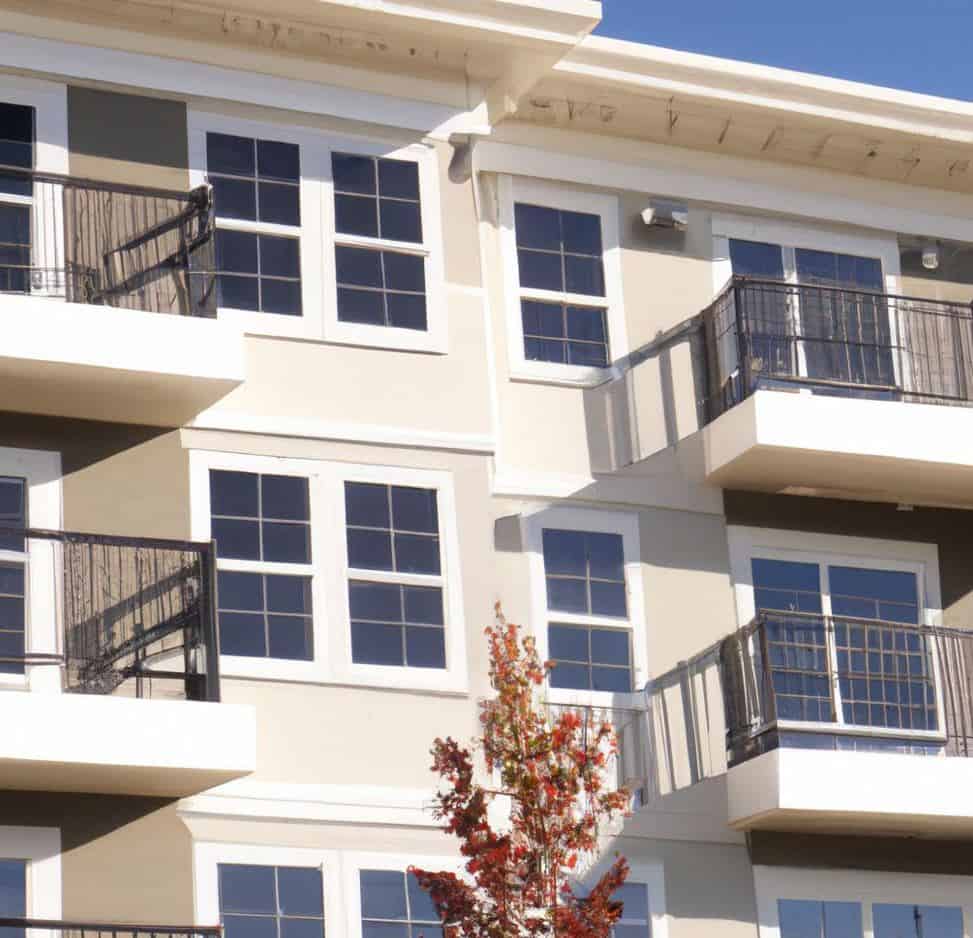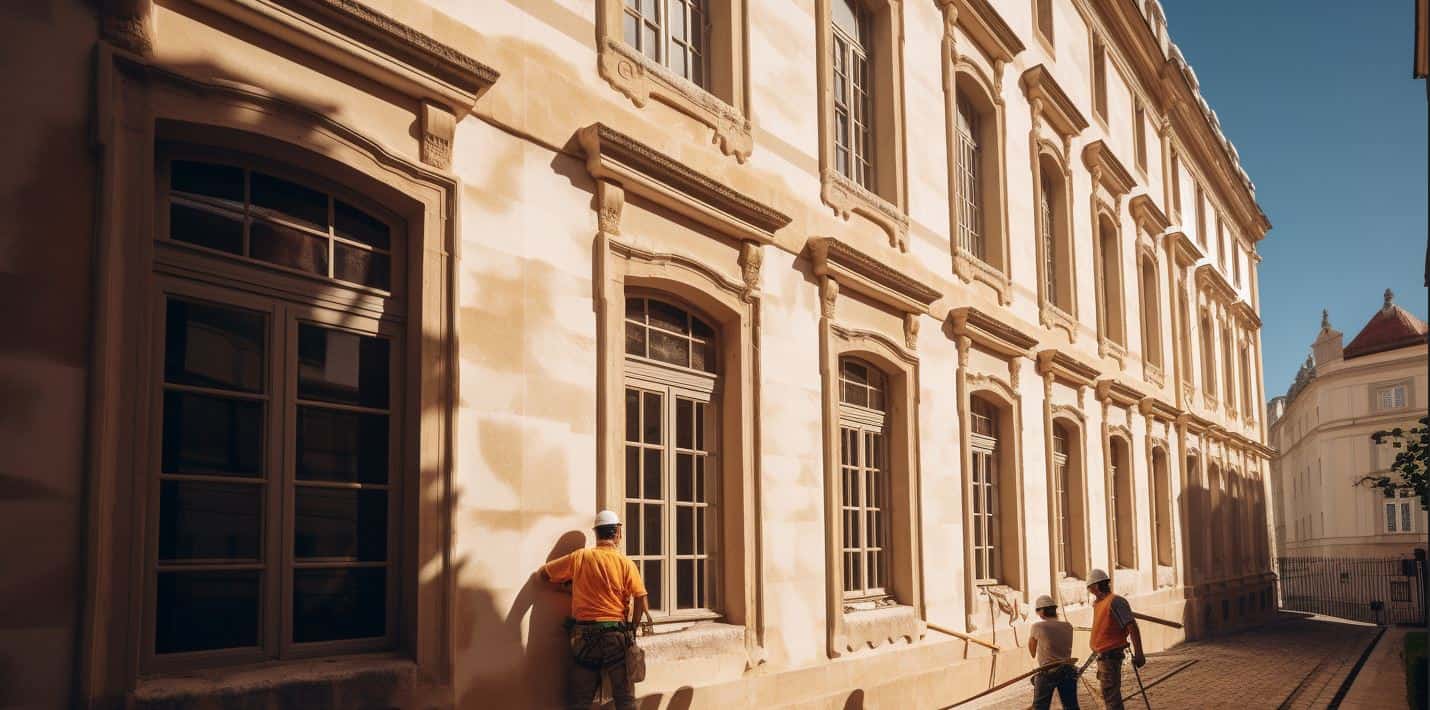From Blueprint to Brilliance: Inside the Journey of an EIFS Transformation
Curious about an EIFS project timeline? Don’t worry! This post provides a guide to the process – from start to finish. Start planning now and avoid the stress of the unknown! Get ready for your project today.
Understanding EIFS (Exterior Insulation and Finish System)
EIFS (Exterior Insulation and Finish System) is a versatile wall cladding system for both residential and commercial construction. It is composed of multiple components that work together to provide insulation, protection, and aesthetic appeal. Benefits of EIFS include improved energy efficiency, moisture control, and design flexibility.
The installation process starts with preparing the substrate and applying a layer of adhesive, followed by the placement of the insulation board. The base coat is then applied over the insulation, followed by the reinforcing mesh. Another layer of base coat is added to embed the mesh securely. Lastly, a finish coat completes the system and creates the desired appearance.
EIFS offers various advantages. It has excellent thermal resistance, reducing energy consumption and utility costs. It also controls moisture infiltration, allowing water vapor to escape while preventing liquid water from entering. Plus, there are many color and texture options for customization.
For example, a commercial building in Houston recently underwent an EIFS renovation. The old brick exterior was replaced to increase energy efficiency and improve the building’s look. The insulation and finish coat were chosen to blend in with the neighborhood architecture, resulting in a modern and sustainable structure.
Initial Planning and Consultation
To begin the project, careful planning and expert consultation is key. Knowing the needs of the project helps with building a solid foundation for successful construction. Here is a breakdown of the ‘Initial Planning and Consultation’ phase:
Activities:
- Project Planning – discussing goals, requirements and deadlines with clients to reach project objectives.
- Professional Consultation – consulting experts for best practices, materials and design considerations.
- Needs Assessment – assessing the project’s needs through site visits, examining existing structures and understanding client needs.
It’s important to understand the client’s vision during this stage. Skipping detailed planning and consultation may lead to problems or mediocre results. Avoid this by investing time in this essential phase for a strong foundation for success. Estimating the timeline for an EIFS project is like trying to predict the weather in a hurricane – chaotic and always changing.
Project Estimation and Timeline Creation
Project Estimation and Timeline Creation is more than just calculating timeframes and costs. It also needs a detailed scope analysis, resource allocation, cost estimating, task scheduling, and risk assessment.
According to Project Management Institute (PMI), accurate project estimation is vital for a successful project. This reduces the likelihood of delays and extra costs.
Selecting the perfect EIFS system is like finding the ideal wingman for a night out. It has to be dependable, attractive, and able to handle some bad choices.
Selecting the Right EIFS System
Selecting the perfect EIFS system? It’s no walk in the park! Location, climate, aesthetics and budget – all must be considered. Professional advice is key here.
Take a look at the table below for important factors to consider when choosing an EIFS system:
| Factor | Importance |
|---|---|
| Location | High |
| Climate Conditions | Moderate |
| Aesthetics | High |
| Budget | Moderate |
Location and aesthetics are the top priorities. Climatic conditions also play a role in your selection.
For example, an EIFS system in a coastal area with high humidity requires moisture-resistance. Professional help is vital to determine the right choice that will deliver long-term durability and aesthetic appeal. The chosen system delivered both moisture management and superior thermal insulation – success!
Bottom line – EIFS system selection is serious business. You need to be patient and get the right advice.
Preparing for EIFS Installation
Before the EIFS Installation: Site Prep and Substrate Readiness Process
- Clear the spot for the EIFS. Remove all debris and obstructions.
- Make sure the substrate is clean, dry, and free of any contaminants that could affect adhesion.
- Check for any structural issues that need to be addressed.
- Apply primer or bonding agent to boost adhesion between substrate and EIFS system.
- Take safety precautions. Provide PPE and ensure a safe workspace.
Pro Tip: Get an experienced contractor to help you through the site prep and substrate readiness for the best results.
Starting the EIFS installation: The base layer is where it all begins. Cover it with hopes of a beautiful finish. Don’t mess it up!
Starting the EIFS Installation: The Base Layer
- Let’s commence the EIFS installation! Firstly, clean and inspect the substrate to make sure it’s suitable for adhesion.
- Repair any surface damages or imperfections.
- Then, apply the base coat evenly with a notched trowel to achieve texture and the correct thickness.
- Whilst the base coat is still wet, embed reinforcement into it, covering all areas for increased durability and strength.
Accurate substrate assessment, careful base coat application, and proper reinforcement embedding are critical to ensure a successful installation process. Don’t miss out on laying a strong foundation for your EIFS project! Follow these steps with precision and efficiency. Professional techniques guarantee long-lasting results. I believe in the power of foam to save us from bad weather and boring facades!
Installing the EIFS Insulation Layer
Prepare the substrate for an effective insulation layer in EIFS by following these steps:
- Clean the substrate and remove any loose materials.
- Apply a bonding agent.
- Fit tightly-secured expanded polystyrene insulation boards.
Then, attach reinforcing mesh over the panels with either adhesive or mechanical fasteners. And don’t forget to apply the base coat – this will provide a solid foundation for the final finish coat.
Once you’re done inspecting, you can proceed to the next steps of the EIFS project with confidence. A well-executed insulation layer boosts energy efficiency and long-term performance. And remember: keep an eye out for moisture intrusion during installation. This’ll prevent any mold or deterioration down the road! So, go ahead and enjoy the last step of the EIFS project – the finish coat!
Applying the EIFS Finish Coat
It’s time to apply the EIFS finish coat once the base coat has dried! This final layer adds beauty and protection against weather.
Here’s a 4-Step Guide on Applying the EIFS Finish Coat:
- Choose the right finish – acrylic, elastomeric, or hybrid.
- Prepare the surface – must be clean, dry, and free from contaminants.
- Apply the finish coat – use a trowel or spray equipment.
- Finishing touches – pay attention to details for a seamless look.
Important Details: The application of the EIFS finish coat is an important milestone in the installation completion. Consult with professionals for expert guidance.
Remember – check the EIFS installation like you would a Jenga tower – if it can withstand wind, it’s probably good to go!
Inspecting and Testing the EIFS Installation
Inspecting and testing EIFS involves a thorough look at quality standards and performance. It makes sure it’s following the right standards and finds any issues or problems before finishing the project.
- Visual Inspection: Check the EIFS to make sure it meets the needed specs. Look for good adhesion, alignment, and system component integrity.
- Moisture Testing: Use tests such as infrared thermography, probe moisture meter testing, or electrical resistance testing. These detect any water infiltration spots.
- Performance Testing: This step evaluates the functionality of the EIFS system. Tests include checking air leakage, thermal performance, sound transmission, and impact resistance.
Also, think about drainage and protection measures. Doing all these steps will help create a high-quality EIFS project. Get a qualified third-party inspector to make sure the EIFS is good and up to professional standards. Last but not least, do the final cleanup.
Post-Installation Cleanup and Site Restoration
Once the EIFS project is finished, it’s post-installation cleanup and site restoration time! Here’s 6 steps to get the job done:
- Clear away debris: EIFS materials, packaging, and waste.
- Clean surfaces: Pressure wash or use cleaning solutions for walls, windows, and other spots.
- Repair any damages: Smaller issues need attention.
- Restore landscaping: Reseed, replant, and repair.
- Inspect for safety: Make sure there’s no risk.
- Finalize paperwork: Update records, get permits, and prepare warranties.
Throughout, communicate with stakeholders for satisfaction! And remember, engage a professional crew experienced in EIFS projects for better results.
First Post-Installation Inspection and Maintenance
After the EIFS system’s installation, it’s vital to perform an initial inspection and maintenance tasks to make sure the system lasts long. A three-step guide for the post-installation inspection and maintenance:
- Inspect the EIFS system in full: Look over the exterior walls closely for any damage, e.g. cracks or moisture seepage. Also, examine all components, such as the insulation board, base coat, reinforcing mesh, and finish coat.
- Handle any repairs or issues: If any harm or shortcomings are noticed during the review, take quick action to repair them. This could involve patching cracks or adding extra layers of coatings to stop further harm.
- Maintain regular upkeep: Once the initial inspection and repairs are done, set up a routine maintenance plan. This should include occasional cleaning of the EIFS surface, taking away debris and dirt that can hurt its performance eventually. Moreover, monitor for any signs of wear or damage and address them right away.
Regular post-installation assessments and preventive maintenance are crucial for maximizing the lifespan of an EIFS system. By dealing with possible issues early on and following proper care practices, you can make sure your EIFS stays in optimal condition for years.
Pro Tip: Think about arranging yearly professional inspections to assess the condition of your EIFS system in depth and detect any underlying issues that may not be immediately obvious. EIFS warranties: giving you hope that your walls won’t collapse faster than a reality TV show marriage!
Understanding Your EIFS Warranty
Comprehending the extent of your EIFS Warranty is essential! It lasts for 10 years and can be transferred. But, certain exclusions like acts of nature are not covered. Homeowners seeking assurance with their EIFS setup must understand the coverage included in the warranty. Having knowledge of what is included and excluded will help avoid any unforeseen costs or difficulties in the future. Maintaining and inspecting EIFS regularly is important, however, you may fear finding something serious that could ruin your day.
Regular EIFS Maintenance and Inspection Schedule
Regular maintenance and inspections are essential to ensure optimal performance of EIFS. By following this schedule, potential issues can be spotted early, avoiding more costly damage and repairs.
See the table below for recommended maintenance and inspections:
| Task | Frequency |
|---|---|
| Cleaning | Annually |
| Joint Inspection | Bi-annually |
| Caulking Replenishment | As needed |
At the annual cleaning, the EIFS system needs a thorough wash to remove any dirt or debris. Bi-annual joint inspections require checking the condition of sealants and dealing with any signs of deterioration or failure. Replenishing caulking is necessary to keep proper sealing.
Be sure to document and address any issues or concerns with a qualified professional, to guarantee appropriate repair measures.
Pro Tip: Regular maintenance and inspections not only lengthen the life of an EIFS system but also catch potential problems before they get worse. Planning ahead will make the project journey like a rollercoaster – exciting, scary, yet satisfying.
Case Study: Real-World EIFS Project Timeline
A real-life case study offers insights into an EIFS project timeline. The table below shows the stages, duration, and key tasks.
| Stage | Duration | Key Tasks |
|---|---|---|
| Planning | 2 weeks | Site assessment, design review, permits |
| Pre-construction | 1 week | Materials, subcontractors, project timeline |
| Construction | 3-4 weeks | Install insulation board, base coat, mesh, top coat |
| Finishing touches | 1-2 weeks | Cleanup, inspections, ensure client satisfaction |
It’s important to note: each project may require more time due to its size. This case study is a general overview of an EIFS project.
Fun fact: EIFS has been used in North America since the late 1960s. It’s a durable, energy-efficient cladding system – the superhero of building exteriors!
Future-Proofing Your Building with EIFS
Using EIFS to Future-Proof Your Building has many advantages!
- Enhanced durability, increased energy efficiency and reduced maintenance costs are just a few of them.
- EIFS can withstand harsh weather and its thermal insulation properties help reduce energy consumption.
- Plus, it offers effective noise reduction and fire resistance.
This makes it perfect for both commercial and residential buildings.
Pro Tip: Make sure you hire experienced professionals specialized in EIFS installation to get the best results.
Frequently Asked Questions
FAQ 1: How long does an EIFS project typically take from start to finish?
Answer: The duration of an EIFS project depends on various factors, such as the size of the building and the complexity of the design. On average, an EIFS project can take anywhere from a few weeks to a few months to complete.
FAQ 2: What are the main steps involved in an EIFS project?
Answer: An EIFS project typically involves four main steps: surface preparation, installation of the insulation layer and basecoat, application of the finish coat, and final detailing and cleaning.
FAQ 3: Is it necessary to hire professionals for an EIFS project?
Answer: It is highly recommended to hire EIFS professionals who have expertise in the specific system. Proper installation and maintenance are crucial for the long-term performance of the EIFS, and professionals ensure compliance with industry standards.
FAQ 4: How can I ensure the durability of an EIFS project?
Answer: To ensure the durability of an EIFS project, it is important to choose high-quality materials, follow proper installation techniques, conduct regular inspections, and undertake necessary maintenance, such as sealant replacement and repair of any damage.
FAQ 5: Are there any specific permits required for an EIFS project?
Answer: Permit requirements vary depending on the location and scope of the project. It is advisable to check with the local authorities or building department to determine if any permits or approvals are needed before starting an EIFS project.
FAQ 6: Can an existing building be retrofitted with EIFS?
Answer: Yes, EIFS can be used for retrofitting existing buildings. The process involves proper evaluation of the building’s structural integrity, surface compatibility, and adherence to building codes. Hiring an EIFS professional is crucial to ensure a successful retrofit project.




